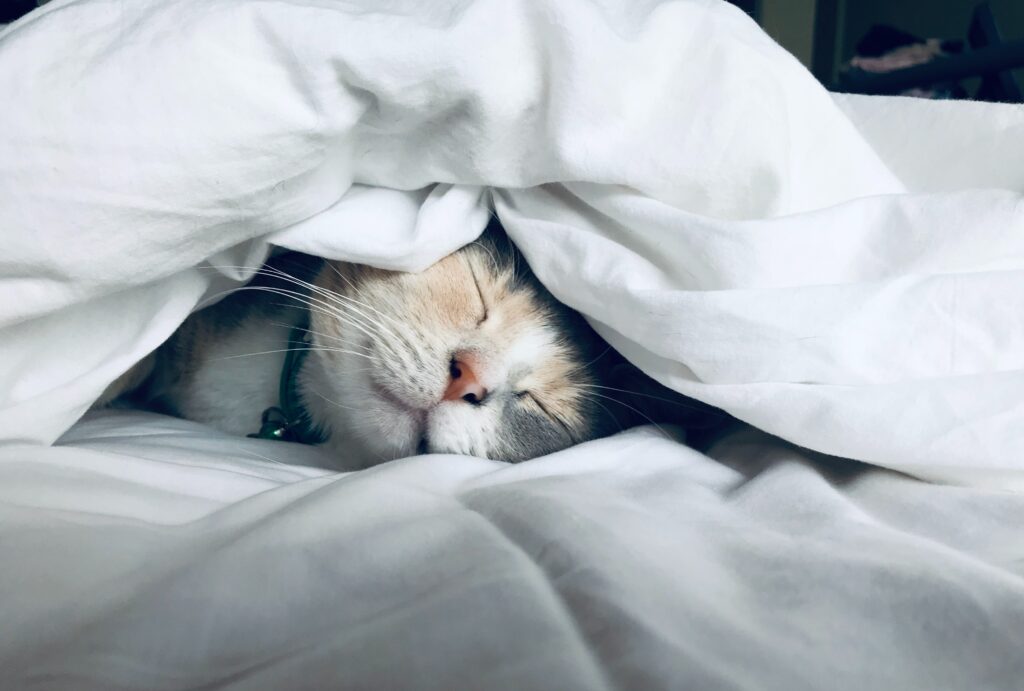Sleep. We all need it. Some of us fair better than others in that department. I’ve been at both ends of the spectrum — I was an insomniac most of my teens and early 20’s, then my child had night-terrors for years, which disrupted my sleep schedule significantly. AAaand I had undiagnosed sleep-apnoea for many years, as well.
Now, I sleep on average 7-9 hours every night, with the usual wake-ups for bathroom or at the end of a sleep cycle (yes, sometimes we come awake as we exit a sleep cycle, the key is to acknowledge it, change your position — flip your pillow for the cold side, if you like that sort of thing! — and tuck back into sleep). And I frequently have friends and family say “I wish I could fall asleep as quickly as you do!”

Here are some of the steps that worked for me to get into a healthier sleep regime:
1) Remove all light sources from the bedroom that are not necessary. For starters, I do not have a digital clock as this is an unneeded light source. Beyond that, there should be no television in the bedroom. The main light and a bedside lamp are truly the only needed lights and they can both be turned off for sleep. According to Harvard health, “Exposure to light suppresses the secretion of melatonin, a hormone that influences circadian rhythms. Even dim light can interfere with a person’s circadian rhythm and melatonin secretion.” Blue light from phones tends to lead to the worst form of this suppression. Black-out curtains over the window(s) are recommended as well. When you turn off your bedside lamp, you want the room to be as dark as possible.
2) The bed is for sleeping. Yes, there are “other activities” that might take place in the bed, but those aside, the bed is a place for sleep. There is no TV watching, or dinner eating, or late-night reading sessions — do these in the living room, or kitchen, or wherever the activity is best carried out. By linking your bed and sleep, when you sit on the edge of the bed as you get ready for sleep, your body will learn this as a cue to start releasing melatonin.
3) Limit strenuous activity before bed. Any exercise or yoga routines should be completed a minimum of 30 minutes prior to bed, longer if possible. By allowing the body to relax before you even get to the bedroom, you are starting part of the difficult process before you even notice it. This can be another good cue to your system to prepare for the release of melatonin. Those “other activities” are also best carried out during the wakeful part of the day, rather than last minute before sleep.
4) No screen time before bed. If you can begin to reduce screen time around 3 hours before bed, then that is wonderful. The aim is at the very least 1 hour before bed if manageable. Start sending your last emails and checking your feeds around the 1 hour mark and be certain you are off an absolute limit of 30 mins before bed. As mentioned above, the blue light from your phone or computer monitor can suppress needed sleep chemicals in the brain. If you need your phone as an alarm clock, get in the habit of leaving it face-down on your bedside table and militantly NOT checking it when you get up for a restroom break in the middle of the night.
5) Other relaxation supports. Having a soft sound, like a bubbling brook or other white noise, can certainly relax the mind and body. It is still recommended this happen outside of the bedroom, perhaps while reclining on the couch and reading a book, or as you unload the dishwasher or fold laundry. Whatever non-screen activity you’ve chosen before bed, a soothing sound can certainly assist in relaxation.
6) Cutting out caffeine before bed. Some people swear by it, others avoid it. Some stop it by noon, others say it doesn’t effect them/their sleep at all. Studies suggest that caffeine can still be at work many hours after consumed. The safest bet is to stop intake of stimulants like caffeine a minimum of 6 hours before bed time. This isn’t an exact science, everyone responds differently to the chemistry in their brain, but it’s a pretty safe bet to make.
7) Noise can be a factor. Other than turning out all lights, blocking windows with black-out curtains, and not having electronics in the bedroom, sound can also be a hindrance. If you live on a busy street with lots of traffic sounds, this is one of the places I might suggest actually using a white-noise playlist in the bedroom, but otherwise, complete silence is a much better way to maintain deep sleep. There will be sounds of the house, or your sleeping companion, or the occasional outdoor noise, but if you are able to fall asleep with these minor interruptions, your brain will turn them into a white sound for you and they shouldn’t bring you awake. Again, if excessive outside loudness if bothersome, a white noise generator is fine. For me, I use a sleep apnea machine, and while it is quiet, there is still a sound to it and that lulls me to sleep every night.
8) Journaling and/or list-making. Sometimes the thing that keeps us from sleep is a running mind. We can’t help but think about the things that happened during the day that we may have wanted to handle differently, or all the things we have to do tomorrow. The best way to deal with these thoughts is to get them out on paper. Journal about your day, and write a list for tomorrow. Once everything is out of your head and in your journal it can become much easier to let these thoughts go. I am out of practice, but this used to be the very start of my bedtime routine (in another space other than bed, usually, though if laying down in bed at the end of your routine works, that’s okay, too!)
9) Routine routine routine. I cannot stress this point enough. Having a good 30 minute routine before bed is key to cuing the body that it is time for sleep. Maybe it includes washing your face, brushing your teeth, setting out clothes for the next day, taking any nighttime medication, drinking a half glass of water, getting undressed and into some pyjamas, and finally climbing in to bed. Whatever your routine looks like, if you carry it out in similar fashion every single night, you will begin cuing the release of melatonin in your brain. Your body will realize that yes, these are the actions that indicate you wish to sleep soon, and you’ll start to get sleepy.
For me, when I sit on the edge of my bed to do anything during the day, my body starts to get sleepy!! I have it cued nicely to associate bed with sleep. I have another chair in my room that I sit on if I need to fold or sort laundry, or interact with any of the other items in my bedroom. But that the bed == sleep has been hard-coded in me for several years now. When I climb in to bed after my bedtime routine, I know it is time to sleep.
Something I didn’t mention above, which might be very specific and not helpful to you, is my sleep position. I’ll share it just in case it gives you a new idea. When I get into bed, I lay on my side with the covers tucked under my arms (so my arms are out). I like to sleep with them under the covers, but while I am going through thoughts of the day or plans for tomorrow, I leave my arms out. As my body under the covers warms up, my arms outside cool down. When I feel I am almost-but-not-quite-ready to sleep, or my arms simply get too cold, I pull them in under the covers with the rest of me. Then I may be in this position for a little bit, still on my side, now fully covered. When I feel myself getting into the deeper stages of near-sleep, I roll over onto my stomach (this is how I fall asleep best) and readjust everything (my CPAP mask, my covers, my pillows) to the perfect position. This process happens, and works, every night for me.
The best thing someone can do for themselves in regards to sleep is to find the steps that work and repeat them. If they are from this list, great, if they are something else entirely, even better! Whatever works for you, keep doing that! If you would like help going through these steps and other ideas, please feel free to reach out to me. I’d love to help you get a good night’s sleep.
